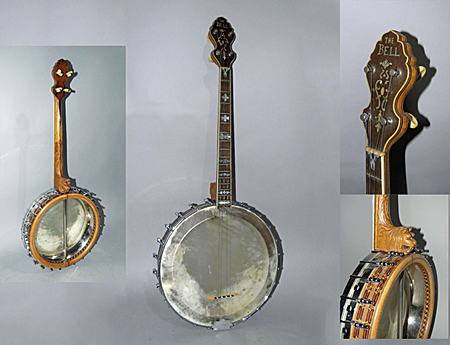
Owner: HWMC
Catalog#: 2CL-CHLT-003
Lutes - Banjos
Banjo: ‘The Bell’- Puntolillo of 'Majestic'
New York City
Gaetano (Thomas) Puntolillo of ‘Majestic’
Metal, wood, Mother-of-Pearl
ca. 1920s
Length: 31.25 in, Diameter: 13 in, Depth: 3 in
Strings – Lutes – Banjos
This 4-string banjo was made by the New York-based Gaetano (Thomas) Puntolillo of “Majestic”. It has a thin skin head, a heavy silver metal rim, and a carved wooden neck with mother-of-pearl inlay on the fretboard. The fretboard has 17 metal frets matching the strings which are also made of metal. The 19-fret tenor banjo is the most common because it gives the banjo a larger range. Nevertheless, this 17-fret tenor banjo has a smaller scale so the frets are closer together, making it easier to play quick single note passages or large chord shape stretches.
The head, where the 4 tuning pegs sit perpendicular to the neck, is also inlaid with mother-of-pearl and bone, reading “The Bell.” The back of the neck, meeting the body, has a lion head carved into it and the inside of the body is also lined with silver metal, giving a clarity of sound. The bridge has some stylized decoration as well, with black and white stripes for each string. The wood of the body is decorated with geometric stained designs and the entire instrument is very ornate.
Research tells us that the banjo we know today comes from a West African instrument known as the ngoni, arriving in America with the slaves brought from Africa. Probably its original resonator was made from a simple gourd (calabash) or wood cut in half, with a dried animal (often goat) skin serving as a soundboard and a neck, over which several strings (usually one short string and the remaining long) were stretched. Thus, early forms of the banjo fashioned by African Americans included the 5-string banjos with one short string and four long strings.
By the late 19th and early 20th centuries, guitar style banjo-playing gained popularity. This new four-string model, known as the tenor style, was played with a plectrum (strumming chordal accompaniment) rather than the classic-banjo fingerpicking style.
Today, the 4-string Tenor Banjo is commonly used for traditional Irish, Gaelic, and Celtic music. It is usually tuned in intervals of the fifth: G, D, A, E, as with viola and mandolas. The 5-string banjos are typically associated with bluegrass and folk music and are tuned to an open ‘G’ chord (GDGBD) and can have between 22 and 26 frets on the neck.
Resource: https://www.deeringbanjos.com/collections/tenor-banjos
